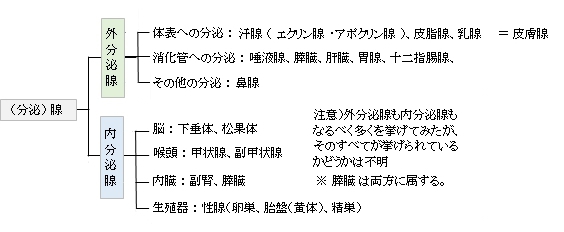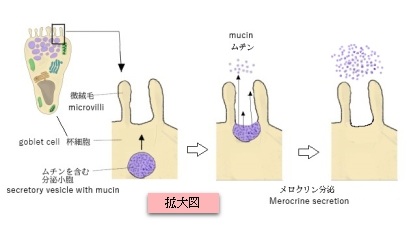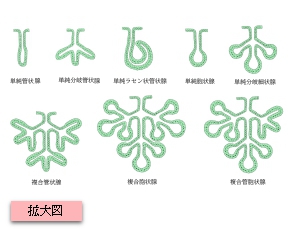


注意)外分泌細胞の一つである杯細胞は腺構造を持たないため外分泌腺には含まれない。

・「(外分泌)腺細胞が集合する領域を終末部と呼ぶ」(ウィキペディア)
【分泌様式】
「ウィキペディア」には以下のような解説文が見られる。
外分泌腺のうち、皮脂腺の様に腺細胞自体が内部に分泌物を蓄えた後に全体が崩壊して外部に排出される様式を全分泌腺(ホロクリン腺)、細胞体は壊れずに腺細胞の生成した分泌物のみ細胞から浸出する様式を漏出分泌腺(エクリン腺)と呼び、この両者の中間的な様式を離出分泌腺(アポクリン腺)と呼ぶ。すなわち、腺細胞が分泌物を生成し、内部に蓄えると、それを保持した細胞の一部が細胞の本体からちぎれて排出され、細胞本体は崩壊せずに繰り返し分泌物をつくりだす。漏出分泌腺と離出分泌腺は厳密には連続する側面があり、漏出分泌腺の腺細胞からも、微細な細胞断片が離出していることが確認されている場合がある。
代表的なものは乳腺で、乳汁はアポクリン腺様式の分泌によって生成する。

「ChatGPT」では細胞の分泌様式を以下の3つに限定している。
|
分泌様式 |
説 明 |
例 |
1 |
メロクリン分泌
=開口分泌 |
分泌物だけを小胞で放出し、細胞自体は損傷しない。 |
膵腺房細胞、唾液腺(耳下腺など) 、杯細胞 |
2 |
アポクリン分泌
=離出分泌 |
細胞の一部(細胞質と膜)がちぎれて分泌される。 |
乳腺、腋下汗腺 |
3 |
ホロクリン分泌
=全分泌、 |
細胞全体が崩壊して分泌物となる。 |
皮脂腺 |
そして「漏出分泌」に関しては以下のように解説している。
「漏出分泌」は上記の3分類に入るのか?
結論:
漏出分泌(diffusion/seepage/leakage)は、この3分類には通常含まれません
【なぜ含まれないのか?】
・能動的な「分泌(secretion)」ではなく、単なる「拡散(diffusion)」や「漏れ(leakage)」とみなされることが多い。
・特に腺組織のような「分泌専門の構造」をもつ細胞では、調節された能動的な分泌のみが対象となる。
・「分泌顆粒や小胞を介さない」ため、厳密には「分泌機構」ではなく「物質の移動様式」に近い。

【分 類】 ※参考:「ウィキペディア」
1. 腺細胞と上皮との位置関係 : 上皮内腺、上皮腺、上皮外腺
2. 終末部と導管の組み合わせ :
| |
タイプ |
例 |
1 |
単純管状腺 |
simple tubular gland
大腸の腸腺(リーベルキューン腺) |
2 |
単純分岐管状腺 |
simple branched tubular gland
胃幽門腺、子宮内膜腺 |
3 |
単純ラセン管状腺 |
simple coiled tubular gland
エクリン汗腺 |
4 |
単純胞状腺 |
simple alveolar gland
人ではほとんど存在せず、胎生期肺や発生初期の膵臓などで見られる |
5 |
単純分岐胞状腺 |
simple branched alveolar gland
皮脂腺 |
6 |
複合管状腺 |
compound tubular gland
十二指腸ブルンネル腺 |
7 |
複合胞状腺 |
compound alveolar gland / compound acinar gland
膵臓の腺房部 |
8 |
複合管胞状腺 |
compound tubuloacinar gland
大唾液腺(耳下腺・顎下腺・舌下腺) |

【種 類】 ※参考:「ウィキペディア」
外分泌腺の全てが挙げられているかどうかは定かではない。
体表へ分泌 |
1 |
|
|
2 |
|
掌・足底を除くほぼ全身の 皮膚に分布する皮脂を分泌する小さな腺 |
3 |
|
♀)乳房にある乳汁を分泌する小さな乳腺葉の塊
※男性では機能退化している |
消化管への分泌 |
1 |
|
|
2 |
|
|
3 |
|
|
4 |
|
|
5 |
十二指腸腺 |
|
6 |
腸 線 |
大腸・小腸の上皮に存在。さまざまな 酵素を分泌 =腸陰窩 |
生殖器 |
1 |
カウパー腺 |
♂)尿道の途中にある2つの豆粒大の器官、尿道球腺液を分泌 |
2 |
前立腺 |
♂)前立腺液(アポクリン分泌)の分泌、アルカリ性、糖、 タンパク質などを含む。 |
3 |
スキーン腺 |
♀)尿道口付近に透明・乳白色の液体を排出。弾性の前立腺に相当 |
4 |
バルトリン腺 |
♀)膣口の左右に一対存在、 粘液(バルトリン腺液)を分泌 =大前庭腺 |
他 |
1 |
|
粘膜呼吸部の粘膜固有層に存在する鼻汁を産出する混合腺 |
2 |
|
眼球の外側よりの上部に位置する涙(液)を分泌する器官 |
【参考となるサイト】
「ウィキペディア」は以下のように解説している。
外分泌腺は、外分泌細胞からの分泌顆粒が直接ないし導管を介して体表あるいは管腔の上皮表面に放出される腺。腺細胞が集合する領域を終末部と呼ぶ。腺細胞と上皮との位置関係により上皮内腺、上皮腺、上皮外腺に、終末部と導管の組み合わせにより管状腺、房状腺、胞状腺、管状胞状腺、管状房状腺に分類される。外分泌されるものとして汗、皮脂、乳、消化液などが存在する。
また以下は英語版は「Wikipedia」の解説文となる。
Exocrine glands are glands that secrete substances on to an epithelial surface by way of a duct. Examples of exocrine glands include sweat, salivary, mammary, ceruminous, lacrimal, sebaceous, prostate and mucous. Exocrine glands are one of two types of glands in the human body, the other being endocrine glands, which secrete their products directly into the bloodstream. The liver and pancreas are both exocrine and endocrine glands; they are exocrine glands because they secrete products—bile and pancreatic juice—into the gastrointestinal tract through a series of ducts, and endocrine because they secrete other substances directly into the bloodstream. Exocrine sweat glands are part of the integumentary system; they have eccrine and apocrine types.
【語句】
・secrete:分泌する ・epithelial:上皮 ・duct:導管 ・salivary:唾液 ・mammary:乳房の ・ceruminous:耳垢の ・lacrimal:涙液の ・sebaseous:脂肪を分泌する ・prostate:前立腺 ・mucous:粘液の ・endocrine gland:内分泌腺 ・pancreas:膵臓 ・bile:胆汁 ・pancreatic juice:膵液 ・gastrointestinal tract:胃腸管 ・integumentary:外皮の ・eccrine:外分泌の ・apocrine:アポクリン
Classification
Structure
Exocrine glands contain a glandular portion and a duct portion, the structures of which can be used to classify the gland.
- The duct portion may be branched (called compound) or unbranched (called simple).
- The glandular portion may be tubular or acinar, or may be a mix of the two (called tubuloacinar). If the glandular portion branches, then the gland is called a branched gland.
Method of secretion
Depending on how their products are secreted, exocrine glands are categorized as merocrine, apocrine, or holocrine.[1]
- Merocrine – the cells of the gland excrete their substances by exocytosis into a duct; for example, pancreatic acinar cells, maximum sweat glands of humans, salivary glands, goblet cells, intestinal glands, tear glands, etc.
- Apocrine – the apical portion of the cytoplasm in the cell membrane, which contains the excretion, buds off. Examples are sweat glands of arm pits, pubic region, skin around anus, lips and nipples; mammary glands, etc.
- Holocrine – the entire cell disintegrates to excrete its substance; for example, sebaceous glands of the skin and nose, meibomian gland, zeis gland, etc.
【語句】
・glandular portion:腺腔部? ・duct portion:導管部? ・tubular: ・acinar:腺房状の ・branched gland:分岐腺 ・merocrine:メロクリン ・apocrine:アポクリン ・holocrine:全分泌の ・excrete: ・exocytosis: ・pancreatic acinar cell:膵腺房細胞 ・salivary gland:唾液腺 ・goblet cell:杯(状)細胞 ・intestinal gland:腸線 ・tear gland:涙腺 ・apical:頂上の ・cytoplasm:細胞質 ・excretion:排泄物 ・arm pit:わきの下 ・pubic:陰部の ・anus:肛門 ・mammary gland:乳腺
Product secreted
【語句】
・serous cell:漿液細胞 ・enzyme:酵素 ・gastric chief cell:胃主細胞 ・Paneth cell:パネート細胞 ・mucous cell:粘液細胞 ・Brunner's gland:ブルンナー腺(=十二支腸腺) ・esophageal gland:食道腺 ・pyloric gland:幽門腺 ・seromucous gland:混合腺 ・salivary gland: ・parotid gland: ・predominantly:主として ・sublingual gland:舌下腺 ・submandibular gland:顎下腺 ・sebaceous gland:皮脂腺 ・sebum:皮脂 ・lipid:脂質 ・oil gland:油胞 ・Fordyce spot:フォーダイス斑点 ・Meibomian gland:マイボーム腺
■ 写真やイラストを掲載しているサイト ■
・ イラストや写真を掲載しているサイト-Ⅰ
・ イラストや写真を掲載しているサイト-Ⅱ
・ イラストや写真を掲載しているサイト-Ⅲ
・ イラストや写真を掲載しているサイト-Ⅳ
